MALAYSIAN HINDU PILGRIMAGE: KAVADI ... - Murugan Bhakti
MALAYSIAN HINDU PILGRIMAGE: KAVADI ... - Murugan Bhakti
MALAYSIAN HINDU PILGRIMAGE: KAVADI ... - Murugan Bhakti
Create successful ePaper yourself
Turn your PDF publications into a flip-book with our unique Google optimized e-Paper software.
(ii) North Indian. Consisted largely of a merchant class, mainly from Gujerat and Bengal, but alsoincluded Sikhs and Pathans, many of whom were recruited into the police and military forces(Sandhu).(iii) Ceylon “Jaffna” Tamils, Recruited throughout the entire colonial period as administrators, theCeylon Tamils were drawn from the dominant Vellalar caste (Rajakrishnan:1986) and observedAgamic “great tradition” Hinduism.(iv) Professional and clerical migrants. These comprised well educated Dravidians, mainly Tamils, butincluded some Malayalees who promoted the wider tenets of orthodox Saiva Siddhanta Hinduism(Arasaratnam:1970: pp 33-34).In 1990 Indians comprised 8% of Malaysia’s population (Far Eastern Economic Review, 7 June 1990).1970 figures indicated that 80% of Malaysian Indians belonged to the working class. Approximately80% were Indian Tamils, 8.1% other Dravidians, 7.7% North Indians and 2.7% Ceylon Tamils.Approximately 80% of Indians identified themselves as Hindus (Rajoo:1983: p. 101).Hinduism in Malaysia has developed in the absence of those traditional sources of authority - thereligious centres of learning or monastic orders (math) which have provided a system of hermeneuticsand scriptural exegesis, and an influential Brahman or orthodox caste - which have shaped Hindustructures, belief systems, mythology and patterns of worship in India.Malaysian Hinduism has historically been dominated by Dravidian folk religions, the so-called “little”traditions or village Hinduism. These have been characterized by the centrality of Mother (Amman)worship, the worship of “little” deities, the construction of non-Agamic temples served by lower castepucari-s (priests), spirit mediumship (sometimes employing rituals based on “left-handed” or“debased” Tantrism), folk beliefs and animal sacrifice. These folkish practices and beliefs continue topervade Malaysian Hinduism at all levels of society, and are often found among educated Hindus(including those who profess an orthodox Saivite/Agamic background).Superficially Malaysian Hinduism remains a loosely integrated system, free of a predominantauthoritative tradition, and containing a bewildering diversity of religious forms. However, thisoutwardly emphatic pluralism masks various unifying tendencies, whose genesis can be traced to postwarHindu reform movements (Arasaratnam:1970: pp 162-176). These groups, which included theinfluential Malayan Hindu Sangam, reflected a renewed interest in the Indian Hindu heritage, and werestrongly steeped in Dravidian ideologies. They aimed at promoting an over-arching model of Agamic(“great tradition”) Hinduism, a reanimation of Tamil arts and literature, and the discouragement oflocal beliefs and practices built around caste, class, sects, and regional loyalties. Centripetal impulsesinclude the Tamilization of Malaysian Hinduism, syncretization of village/ Agamic Hinduism as wellas Saivite/Vasihnavite motifs, a process of Sanskritization/Agamicization, and the popularization ofmajor Sanskritic festivals (Rajoo:1984:p.105).These unificatory impulses have been fuelled by a perceived need to reinterpret traditional forms ofHinduism to create a Hindu identity more responsive to the imperatives of multi-ethnic Malaysia. Theparadigmatic model of reform has been Saiva Siddhanta, an orthodox Agamic philosophical system ofSaivism, practiced and propagated by upper class and educated Hindus (Arasaratnam:1970:p.167). Thepromotion of Saiva Siddhanta has been assisted by the gradual blurring of caste boundaries(Rajoo:1983:p.102) which has softened traditional hierarchical divisions of religious practice andbelief. Reformulation of Hinduism has been impelled by issues of class and status. Agamicization isviewed by working and lower class Hindus as not only a method of seeking a common cultural alliancewith upper class Hindus, an affirmation of group cohesion, but also a means of attaining identificationby the dominant Malaysian ethnic groups as equal partners with higher status Indians within anancient, rich and defining philosophical and religious tradition (Rajoo:1984:p.168).The central unifying factor in the tortuous recasting of Malaysian Hinduism is the deity <strong>Murugan</strong>, whoreaches most sectors of Malaysian Hindu society. <strong>Murugan</strong> is a pan-Tamil Agamic identity, readilyaccepted within the framework of Saiva Siddhanta. Moreover, through a protracted process ofsyncretism, <strong>Murugan</strong> has absorbed a broad range of motifs, attributes and belief structures which



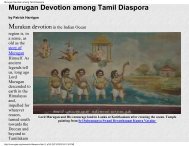

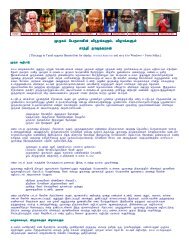

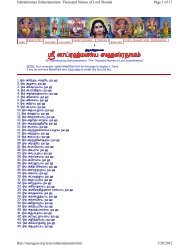

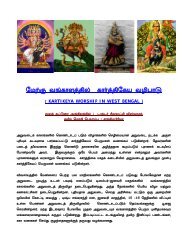
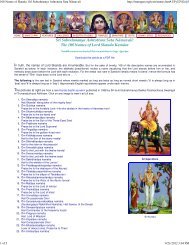
![gHdp k]y Myaj;jpw;F ghj ahj;jpiu fpuhkpa gHf;f Kiwfs;](https://img.yumpu.com/10245948/1/184x260/ghdp-ky-myajjpwf-ghj-ahjjpiu-fpuhkpa-ghff-kiwfs.jpg?quality=85)

